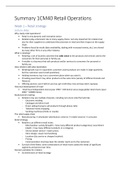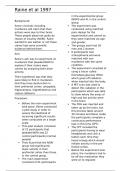Summary
Summary 1CM40 Retail Operations
- Course
- Institution
Summary of all lecture slides sorted per week, and the required readings: Thorbeck 2017 Retail Strategy Van Donselaar et al 2005 Improvement in Retail Operations Van Donselaar & Broekmeulen 2021 Lecture Notes Inventory Control Pants meulen & Van Donselaar 2009 Heuristic for perishables Broek...
[Show more]












